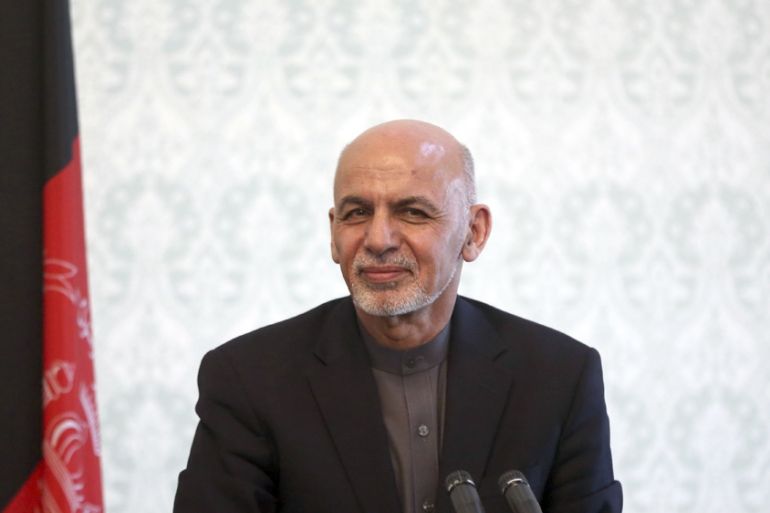Afghanistan’s ceasefire with Taliban: ‘Are we safe now?’
As President Ghani announced a temporary ceasefire with Taliban fighters, Afghans fear security will deteriorate.

When President Ashraf Ghani announced a temporary ceasefire with the Taliban on Thursday, Shafiqa Rahimi, a widow of a security force member, recalled how “bravely” her husband fought the Taliban in the southeastern province of Ghazni.
“I am surprised, this decision is an insult to us and my husband who fought the Taliban so bravely,” the 24-year-old told Al Jazeera.
Keep reading
list of 4 itemsPhotos: Malnutrition threatens future Afghan generations
Photos: Tourist numbers up in post-war Afghanistan
Taliban ban on girls’ education defies both worldly and religious logic
Ghani ordered security forces to cease operations against the armed group until June 20, coinciding with the end of fasting month of Ramadan and the Islamic holiday of Eid al–Fitr.
The ceasefire excludes all other armed groups, such as the Islamic State of Iraq and the Levant (ISIL, also known as ISIS) group.
“How can the president announce a ceasefire with the Taliban?” Shafiqa asks
“My husband fought for the safety and security of the country, ceasefire with the Taliban makes us vulnerable to them.”
Decade-long fight
Violence has spread across Afghanistan in recent weeks with heavy fighting taking place between the Taliban and the security forces from the provinces of Badakhshan, Baghlan and Faryab in the north to Farah in the west.
Last month, Farah city, one of the largest cities of Afghanistan, was on the verge of falling to the Taliban, which would have made it the second city, after Kunduz in 2015, to fall under the Taliban since the war began in 2001.
In an attempt to put an end the decade-long fight, in February, Ghani offered recognition of the Taliban as a legitimate political group and involvement in a constitutional review that he said could bring the group to the negotiating table to end the 16-year-old war.
The Taliban continued fighting and instead sent an invitation to the US for talks.
According to a recent report by the Special Inspector General for Afghanistan Reconstruction (SIGAR), 229 districts were under Afghan government control – about 56.3 percent of total Afghan districts – as of January 31, 2018.
There were 59 districts – approximately 14.5 percent – under the armed group’s control.
The remaining 119 districts – about 29.2 percent – are contested, controlled by neither the Afghan government nor the armed group.
A military commander, who wishes to remain anonymous because he is not authorised to speak, raised a question after the announcement.
“With so many militant groups active here, how do we identify who is the Taliban and who is not?” he said.
“The areas where we are fighting to push back the Taliban, will be taken over by them, is the president allowing this to happen? I don’t understand.”
The military commander also said that the Taliban had ‘brutally’ killed police and members of the security forces and “cannot be made peace with”.
“The Taliban want to take over the country and have the foreign forces out. Our brothers [police and soldiers] have sacrificed their lives for this fight, and after this announcement, we are helpless and cannot even protect our people or even us.”
Spring offensive
The latest report disclosing Afghan security forces casualty figures was in July 2017. A total of 2,531 members of the Afghan forces had been killed, and 4,238 wounded in the first four months of 2017.
Hundreds of soldiers and police officers have been killed since the Taliban launched their spring offensive in April this year in a bid to control large swaths of the country.
Amir Yagana, a Kabul resident, believes Ghani’s ceasefire decision is to put pressure on the Taliban for peace talks, and a desperate attempt to end the war in the country.
“They want to ally with the Taliban so they can fight the other militant groups together, but I need to know about us civilians,” he said.
In a report published on April 12, the United Nations Assistance Mission in Afghanistan (UNAMA) said 763 civilians had been killed, and 1,495 others injured, between January 1 and March 31, 2018. A six percent increase in cases was attributed to anti-government forces, mainly the Taliban and ISIL.
On-ground battles were the second-leading cause of civilian deaths and injuries according to the report.
“After this ceasefire, are we safe now?” Yagana asks.